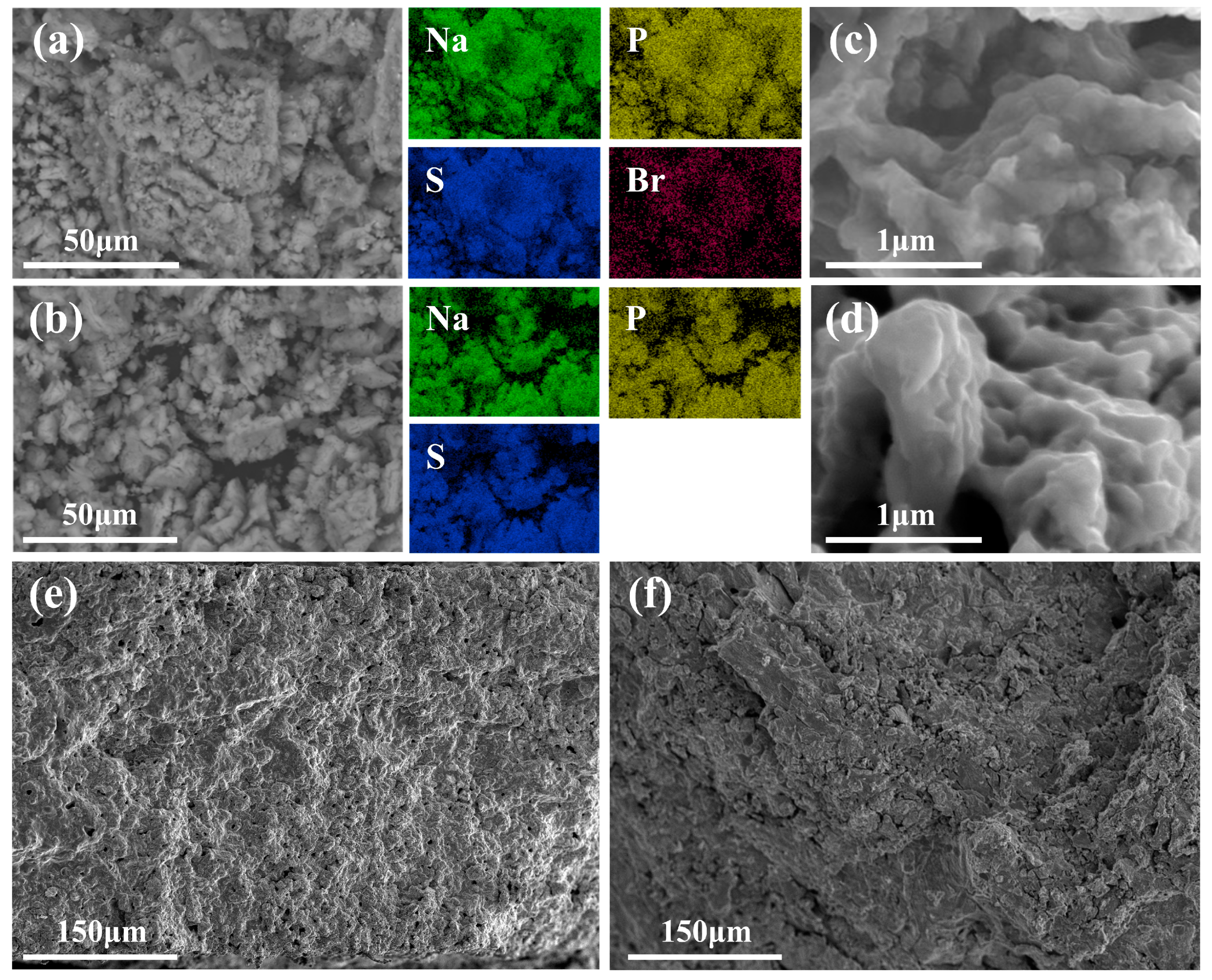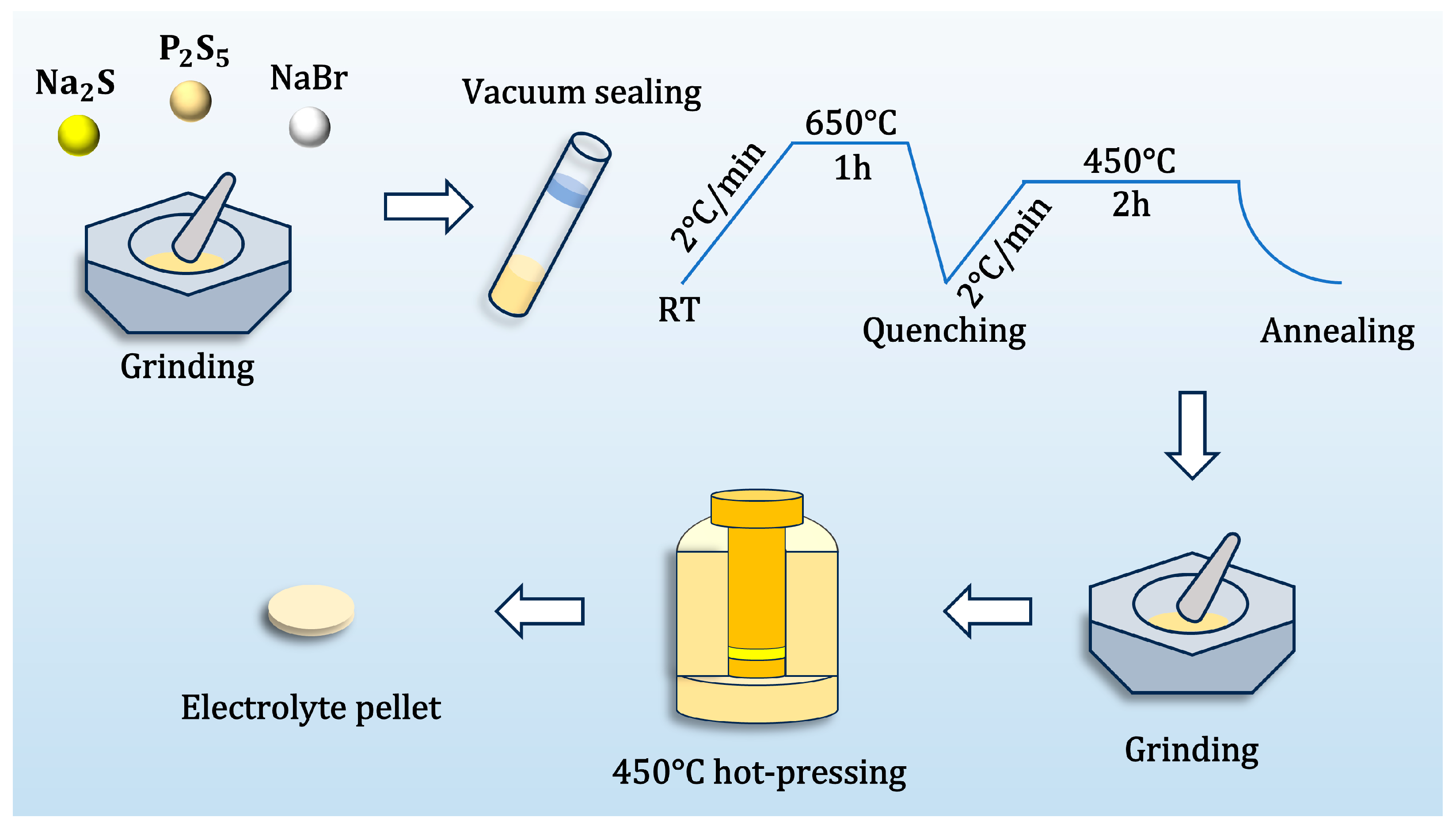Fabrication and Electrochemical Performance of Br-Doped Na3PS4 Solid-State Electrolyte for Sodium–Sulfur Batteries via Melt-Quenching and Hot-Pressing
Abstract
1. Introduction
2. Results and Discussion
2.1. Crystal Structure Analysis
2.2. Morphological and Elemental Analysis
2.3. Electrochemical Performance Analysis
3. Materials and Methods
3.1. Synthesis
3.2. Characterization of Solid-State Electrolytes
3.3. Electrochemical Characterization
4. Conclusions
Author Contributions
Funding
Data Availability Statement
Conflicts of Interest
References
- Deysher, G.; Chen, Y.T.; Sayahpour, B.; Lin, S.W.; Ham, S.Y.; Ridley, P.; Cronk, A.; Wu, E.A.; Tan, D.H.S.; Doux, J.M.; et al. Evaluating Electrolyte-Anode Interface Stability in Sodium All-Solid-State Batteries. ACS Appl. Mater. Interfaces 2022, 14, 47706–47715. [Google Scholar] [CrossRef]
- Chi, X.; Zhang, Y.; Hao, F.; Kmiec, S.; Dong, H.; Xu, R.; Zhao, K.; Ai, Q.; Terlier, T.; Wang, L.; et al. An electrochemically stable homogeneous glassy electrolyte formed at room temperature for all-solid-state sodium batteries. Nat. Commun. 2022, 13, 2854. [Google Scholar] [CrossRef] [PubMed]
- Hueso, K.B.; Armand, M.; Rojo, T. High temperature sodium batteries: Status, challenges and future trends. Energy Environ. Sci. 2013, 6, 734–749. [Google Scholar] [CrossRef]
- Braga, M.H.; Grundish, N.S.; Murchison, A.J.; Goodenough, J.B. Alternative strategy for a safe rechargeable battery. Energy Environ. Sci. 2017, 10, 331–336. [Google Scholar] [CrossRef]
- Huang, B.; Yao, X.; Huang, Z.; Guan, Y.; Jin, Y.; Xu, X. Li3PO4-doped Li7P3S11 glass-ceramic electrolytes with enhanced lithium ion conductivities and application in all-solid-state batteries. J. Power Sources 2015, 284, 206–211. [Google Scholar] [CrossRef]
- Ohtomo, T.; Hayashi, A.; Tatsumisago, M.; Tsuchida, Y.; Hama, S.; Kawamoto, K. All-solid-state lithium secondary batteries using the 75Li2S·25P2S5 glass and the 70Li2S·30P2S5 glass–ceramic as solid electrolytes. J. Power Sources 2013, 233, 231–235. [Google Scholar] [CrossRef]
- Deng, Z.; Wang, Z.; Chu, I.-H.; Luo, J.; Ong, S.P. Elastic Properties of Alkali Superionic Conductor Electrolytes from First Principles Calculations. J. Electrochem. Soc. 2015, 163, A67–A74. [Google Scholar] [CrossRef]
- Sakuda, A.; Hayashi, A.; Tatsumisago, M. Sulfide Solid Electrolyte with Favorable Mechanical Property for All-Solid-State Lithium Battery. Sci. Rep. 2013, 3, 2261. [Google Scholar] [CrossRef]
- Guo, X.; Halacoglu, S.; Chen, Y.; Wang, H. Recent Progress on Dominant Sulfide-Type Solid-State Na Superionic Conductors for Solid-State Sodium Batteries. Small 2024, 20, 2311195. [Google Scholar] [CrossRef]
- Zhao, C.; Liu, L.; Qi, X.; Lu, Y.; Wu, F.; Zhao, J.; Yu, Y.; Hu, Y.S.; Chen, L. Solid-State Sodium Batteries. Adv. Energy Mater. 2018, 8, 1703012. [Google Scholar] [CrossRef]
- Bachman, J.C.; Muy, S.; Grimaud, A.; Chang, H.-H.; Pour, N.; Lux, S.F.; Paschos, O.; Maglia, F.; Lupart, S.; Lamp, P.; et al. Inorganic Solid-State Electrolytes for Lithium Batteries: Mechanisms and Properties Governing Ion Conduction. Chem. Rev. 2015, 116, 140–162. [Google Scholar] [CrossRef]
- Deng, Z.; Mo, Y.; Ong, S.P. Computational studies of solid-state alkali conduction in rechargeable alkali-ion batteries. NPG Asia Mater. 2016, 8, e254. [Google Scholar] [CrossRef]
- Anantharamulu, N.; Koteswara Rao, K.; Rambabu, G.; Vijaya Kumar, B.; Radha, V.; Vithal, M. A wide-ranging review on Nasicon type materials. J. Mater. Sci. 2011, 46, 2821–2837. [Google Scholar] [CrossRef]
- Hayashi, A.; Noi, K.; Sakuda, A.; Tatsumisago, M. Superionic glass-ceramic electrolytes for room-temperature rechargeable sodium batteries. Nat. Commun. 2012, 3, 856. [Google Scholar] [CrossRef] [PubMed]
- Hayashi, A.; Noi, K.; Tanibata, N.; Nagao, M.; Tatsumisago, M. High sodium ion conductivity of glass–ceramic electrolytes with cubic Na3PS4. J. Power Sources 2014, 258, 420–423. [Google Scholar] [CrossRef]
- Krauskopf, T.; Culver, S.P.; Zeier, W.G. Local Tetragonal Structure of the Cubic Superionic Conductor Na3PS4. Inorg. Chem. 2018, 57, 4739–4744. [Google Scholar] [CrossRef] [PubMed]
- de Klerk, N.J.J.; Wagemaker, M. Diffusion Mechanism of the Sodium-Ion Solid Electrolyte Na3PS4 and Potential Improvements of Halogen Doping. Chem. Mater. 2016, 28, 3122–3130. [Google Scholar] [CrossRef]
- Yu, C.; Ganapathy, S.; de Klerk, N.J.J.; van Eck, E.R.H.; Wagemaker, M. Na-ion dynamics in tetragonal and cubic Na3PS4, a Na-ion conductor for solid state Na-ion batteries. J. Mater. Chem. A 2016, 4, 15095–15105. [Google Scholar] [CrossRef]
- Seo, J.Y.; Shim, S.; Lee, J.-W.; Lee, B.D.; Park, S.; Park, W.B.; Han, S.; Pyo, M.; Sohn, K.-S. Multi-variable Bayesian optimization for a new composition with high Na+ conductivity in the Na3PS4 family. J. Mater. Chem. A 2022, 10, 1831–1839. [Google Scholar] [CrossRef]
- He, R.; Hu, Z.; Gao, J.; Zhang, G.; Shen, K. Role of Halogen Doping on Ionic Diffusion in the Grain Boundary Structure of Cubic Na3PS4: Ab Initio Molecular Dynamic Study. J. Phys. Chem. C 2022, 126, 10593–10600. [Google Scholar] [CrossRef]
- Zhu, Z.; Chu, I.-H.; Deng, Z.; Ong, S.P. Role of Na+ Interstitials and Dopants in Enhancing the Na+ Conductivity of the Cubic Na3PS4 Superionic Conductor. Chem. Mater. 2015, 27, 8318–8325. [Google Scholar] [CrossRef]
- Tanibata, N.; Hayashi, A.; Tatsumisago, M. Improvement of Rate Performance for All-Solid-State Na15Sn4/Amorphous TiS3 Cells Using 94Na3PS4·6Na4SiS4 Glass-Ceramic Electrolytes. J. Electrochem. Soc. 2015, 162, A793–A795. [Google Scholar] [CrossRef]
- Chu, I.-H.; Kompella, C.S.; Nguyen, H.; Zhu, Z.; Hy, S.; Deng, Z.; Meng, Y.S.; Ong, S.P. Room-Temperature All-solid-state Rechargeable Sodium-ion Batteries with a Cl-doped Na3PS4 Superionic Conductor. Sci. Rep. 2016, 6, 33733. [Google Scholar] [CrossRef] [PubMed]
- Kim, J.-K.; Lim, Y.J.; Kim, H.; Cho, G.-B.; Kim, Y. A hybrid solid electrolyte for flexible solid-state sodium batteries. Energy Environ. Sci. 2015, 8, 3589–3596. [Google Scholar] [CrossRef]
- Lu, Y.; Li, L.; Zhang, Q.; Niu, Z.; Chen, J. Electrolyte and Interface Engineering for Solid-State Sodium Batteries. Joule 2018, 2, 1747–1770. [Google Scholar] [CrossRef]
- Yu, L.; Jiao, Q.; Liang, B.; Shan, H.; Lin, C.; Gao, C.; Shen, X.; Dai, S. Exceptionally high sodium ion conductivity and enhanced air stability in Na3SbS4 via germanium doping. J. Alloy. Compd. 2022, 913, 165229. [Google Scholar] [CrossRef]
- Huang, H.; Wu, H.-H.; Wang, X.; Huang, B.; Zhang, T.-Y. Enhancing sodium ionic conductivity in tetragonal-Na3PS4 by halogen doping: A first principles investigation. Phys. Chem. Chem. Phys. 2018, 20, 20525–20533. [Google Scholar] [CrossRef] [PubMed]
- Kraft, M.A.; Gronych, L.M.; Famprikis, T.; Zeier, W.G. Influence of Reduced Na Vacancy Concentrations in the Sodium Superionic Conductors Na11+xSn2P1–xMxS12 (M=Sn, Ge). ACS Appl. Energy Mater. 2021, 4, 7250–7258. [Google Scholar] [CrossRef]
- Xiulin, F.; Jie, Y.; Fudong, H.; Ji, C.; Tao, D.; Xiuquan, Z.; Singyuk, H.; Chunsheng, W. High-Performance All-Solid-State Na-S Battery Enabled by Casting-Annealing Technology. Acs Nano 2018, 12, 3360–3368. [Google Scholar] [CrossRef]





| Preparation Method | Thickness (mm) | Bulk Resistance (Ω) | Interface Resistance (Ω) | Total Resistance (Ω) | Ionic Conductivity (S/cm) |
|---|---|---|---|---|---|
| Ball-milled Na3PS4-270 °C | 0.81 | 421.24 | 5585.00 | 6006.24 | 1.72 × 10−5 |
| Ball-milled Na3PS4-450 °C | 0.81 | 401.88 | 3722.00 | 4123.88 | 2.50 × 10−5 |
| Na3PS4 without annealing | 0.59 | 257.71 | 855.00 | 1112.71 | 6.76 × 10−5 |
| Na3PS4-270 °C | 0.50 | 180.53 | 292.00 | 472.53 | 1.35 × 10−4 |
| Na3PS4-450 °C | 0.58 | 105.52 | 62.16 | 167.68 | 4.41 × 10−4 |
| Na2.9375PS3.9375Br0.0625-450 °C | 0.57 | 58.62 | 45.81 | 104.43 | 6.95 × 10−4 |
| Na2.9PS3.9Br0.1-450 °C | 0.56 | 62.93 | 23.19 | 86.12 | 8.28 × 10−4 |
| Na2.875PS3.875Br0.125-450 °C | 0.51 | 61.10 | 111.2 | 172.30 | 3.77 × 10−4 |
| Na2.85PS3.85Br0.15-450 °C | 0.55 | 64.34 | 212.6 | 276.94 | 2.53 × 10−4 |
| Na2.9PS3.9Br0.1 450 °C hot-pressing | 0.63 | 44.93 | 25.10 | 70.03 | 1.15 × 10−3 |
Disclaimer/Publisher’s Note: The statements, opinions and data contained in all publications are solely those of the individual author(s) and contributor(s) and not of MDPI and/or the editor(s). MDPI and/or the editor(s) disclaim responsibility for any injury to people or property resulting from any ideas, methods, instructions or products referred to in the content. |
© 2025 by the authors. Licensee MDPI, Basel, Switzerland. This article is an open access article distributed under the terms and conditions of the Creative Commons Attribution (CC BY) license (https://creativecommons.org/licenses/by/4.0/).
Share and Cite
Ma, A.; Liu, S.; Li, D.; Gu, B.; Li, S.; Wang, J. Fabrication and Electrochemical Performance of Br-Doped Na3PS4 Solid-State Electrolyte for Sodium–Sulfur Batteries via Melt-Quenching and Hot-Pressing. Inorganics 2025, 13, 73. https://doi.org/10.3390/inorganics13030073
Ma A, Liu S, Li D, Gu B, Li S, Wang J. Fabrication and Electrochemical Performance of Br-Doped Na3PS4 Solid-State Electrolyte for Sodium–Sulfur Batteries via Melt-Quenching and Hot-Pressing. Inorganics. 2025; 13(3):73. https://doi.org/10.3390/inorganics13030073
Chicago/Turabian StyleMa, Ao, Shuhui Liu, Degui Li, Bin Gu, Sheng Li, and Jing Wang. 2025. "Fabrication and Electrochemical Performance of Br-Doped Na3PS4 Solid-State Electrolyte for Sodium–Sulfur Batteries via Melt-Quenching and Hot-Pressing" Inorganics 13, no. 3: 73. https://doi.org/10.3390/inorganics13030073
APA StyleMa, A., Liu, S., Li, D., Gu, B., Li, S., & Wang, J. (2025). Fabrication and Electrochemical Performance of Br-Doped Na3PS4 Solid-State Electrolyte for Sodium–Sulfur Batteries via Melt-Quenching and Hot-Pressing. Inorganics, 13(3), 73. https://doi.org/10.3390/inorganics13030073






